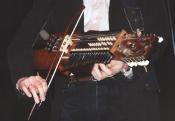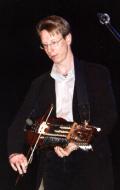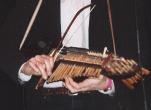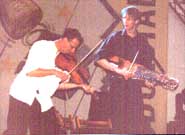FolkWorld article by Christian Moll:
From Viking's Worlds: Väsen
 Väsen - the Swedish band with the "ä". You should never name them Vasen, the dots are extremely important, as "Vasen" is for Swedes totally uncool meaning (well you might guess it) "a vase". Yet "A Vase" would be a weak name for one of the most exciting acts out of Sweden...
Väsen - the Swedish band with the "ä". You should never name them Vasen, the dots are extremely important, as "Vasen" is for Swedes totally uncool meaning (well you might guess it) "a vase". Yet "A Vase" would be a weak name for one of the most exciting acts out of Sweden...
"Väsen means something like essence, spirit, being (like the German related word "das Wesen"), but at the same time also noise, bad sounds. So Väsen means something like "noisy" and "being" - it has many meanings."
The band started as a trio in 1980 - there was Mikael on the viola, Roger on guitar and Olov on the Nyckelharpa (Sweden's national instrument, a keyed fiddle). It was more by chance that the band started, says Olov: "We were asked by a man who heard Roger and me play. He wanted to do a recording with us, and then we asked Mikael to join us. So we did the recording, and we called our first CD 'Väsen'. Then people started to call and they said 'we want Väsen to come and play'. So we took the name of our first CD as a band name."
The three musicians have known each other for a long time before this had happened. " We come from the same area, from Väster Uppland, a Swedish region, just north of Stockholm."
 They have toured as a trio for several years, until they met Andre. " I think it was 5 years ago since we met Andre the first time. Playing after a kind of a folk rock act we met him. All four musicians liked each other, had a good time and, 'hey we should meet some time and rehearse'. So we did and since that time we have been a quartet."
They have toured as a trio for several years, until they met Andre. " I think it was 5 years ago since we met Andre the first time. Playing after a kind of a folk rock act we met him. All four musicians liked each other, had a good time and, 'hey we should meet some time and rehearse'. So we did and since that time we have been a quartet."
They have released up to now two albums as a quartet, the first 'Världens Väsen' ('The World's Noise' or 'The Essence of the World'), and the second 'Gront' (which can be won in FolkWorld!) which was released in 1999.
"We play both our own material and traditional tunes. We learned the traditional material from old fiddlers or picked it up from old books - written music, collections made by people in the 18th century. Some of our own material is very much in the tradition, you couldn't tell that it is a new composed tune, if you do not have a lot of knowledge about the music. But sometimes, some of the new material stretches out towards new ground that nobody has stepped on before. Each of us usually composes the melodies just on his own, and then we arrange the music together."
Olov and Mikael have had nearly the same musical repertoire when they met for the first time. Explains Olov: "I met a very good and well known fiddle master, he asked me to come and listen to learn the tunes. And that's what I have done. Mikael, he went to the brother of the old guy I went to. So we met, and we had kind of the same repertoire. 'Hey do you know this tune?' - 'Yes I do!' So we were playing for several hours already the first time we met."
Olov started to play on the nyckelharpa because his mother bought one when he was young, his uncle played it also.
 The nyckelharpa is a very old instrument. The oldest picture is a stone carving on a church on the island of Gotland in the Baltic sea, the church is from 1350 - so the nyckelharpa has been around already in those days. It was played during the middle ages, and they have been developed all the time. Sometimes it was a very popular instrument, and sometimes the tradition of the nyckelharpa was nearly fading away.
The nyckelharpa is a very old instrument. The oldest picture is a stone carving on a church on the island of Gotland in the Baltic sea, the church is from 1350 - so the nyckelharpa has been around already in those days. It was played during the middle ages, and they have been developed all the time. Sometimes it was a very popular instrument, and sometimes the tradition of the nyckelharpa was nearly fading away.
In the early 20th century it was very close to disappear - in1940 there were only perhaps 20 people left in Uppland who knew how to play it and how to build it. "But then it kind of changed the late 60th, early 70th - people started to build them, and learn how to play them. And now it is very established again. You can study it at schools, at music schools and the conservatory."
The nyckelharpa has become now again a quite common instrument, there are probably 10.000 people in Sweden who play it. "And it is spreading now - there is a American Nyckelharpa association with about 200 members and they are very active. Also in France there are several players, I know a few people in Germany who play it, but not very many."
 The current folk scene in Sweden is quite healthy. "There is quite much happening, the festival scene is kind of vital, and new places are popping up where we can play. Many new bands are coming, especially from - there is a new folk music department in Stockholm, where we are teaching, the three of us (Mikael, Roger and Olov). And new bands are coming out of this, some of them are really good and talented. There is a lot of education now; you can go and study traditional music. That is creating both audiences and musicians. Dancing to the traditional music is also popular - both dances on stage like a dance company and just dancing for fun. So it seems that we are having a good time for traditional music in Sweden."
The current folk scene in Sweden is quite healthy. "There is quite much happening, the festival scene is kind of vital, and new places are popping up where we can play. Many new bands are coming, especially from - there is a new folk music department in Stockholm, where we are teaching, the three of us (Mikael, Roger and Olov). And new bands are coming out of this, some of them are really good and talented. There is a lot of education now; you can go and study traditional music. That is creating both audiences and musicians. Dancing to the traditional music is also popular - both dances on stage like a dance company and just dancing for fun. So it seems that we are having a good time for traditional music in Sweden."
While there is these days a strong focus on folk music education, at the same time the passed-on traditions live on. There is still a strong tradition in diverse of Sweden, not everywhere, but in certain places. The fiddler's Spelmanslags are going strong - "a Spelmanslag is a group of fiddlers, it was kind of invented in the early 19th as people got together and played. The really traditional way was only one or two fiddlers together, but then it was something like a social thing, just to get together. It can be 100 fiddlers playing on the same stage. The Spelmanslags are doing a great job, bringing young people in learning from the old."
Part of the current success and popularity of Swedish music goes back also on the existence of Väsen. This band has brought a new kind of cool feeling to trad Swedish music, still very close to the tradition, but nevertheless cool, danceable, trendy.
Latest published CD: Gront, on Xource Records
WIN Väsen CDs!
You can win one of two of the new album of Swedens top band. To take part in the competition, answer the following question: One of Väsen's band members has contributed to another brilliant Scandinavian CD which is reviewed in this issue. Who is it, and which CD was it?
Answers until 19/05/2000 to FolkWorld.
Photo Credit: Väsen at Rudolstadt festival 1999 and Tilburg festival 2000, all photos by the Mollis
Back to the content of FolkWorld Articles & live reviews
To the content of FolkWorld online magazine Nr. 13
© The Mollis - Editors of FolkWorld; Published 3/2000
All material published in FolkWorld is © The Author via FolkWorld. Storage for private use is allowed and welcome. Reviews and extracts of up to 200 words may be freely quoted and reproduced, if source and author are acknowledged. For any other reproduction please ask the Editors for permission.
FolkWorld - Home of European Music

Layout & Idea of FolkWorld © The Mollis - Editors of FolkWorld
 Väsen - the Swedish band with the "ä". You should never name them Vasen, the dots are extremely important, as "Vasen" is for Swedes totally uncool meaning (well you might guess it) "a vase". Yet "A Vase" would be a weak name for one of the most exciting acts out of Sweden...
Väsen - the Swedish band with the "ä". You should never name them Vasen, the dots are extremely important, as "Vasen" is for Swedes totally uncool meaning (well you might guess it) "a vase". Yet "A Vase" would be a weak name for one of the most exciting acts out of Sweden...
 They have toured as a trio for several years, until they met Andre. " I think it was 5 years ago since we met Andre the first time. Playing after a kind of a folk rock act we met him. All four musicians liked each other, had a good time and, 'hey we should meet some time and rehearse'. So we did and since that time we have been a quartet."
They have toured as a trio for several years, until they met Andre. " I think it was 5 years ago since we met Andre the first time. Playing after a kind of a folk rock act we met him. All four musicians liked each other, had a good time and, 'hey we should meet some time and rehearse'. So we did and since that time we have been a quartet." The nyckelharpa is a very old instrument. The oldest picture is a stone carving on a church on the island of Gotland in the Baltic sea, the church is from 1350 - so the nyckelharpa has been around already in those days. It was played during the middle ages, and they have been developed all the time. Sometimes it was a very popular instrument, and sometimes the tradition of the nyckelharpa was nearly fading away.
The nyckelharpa is a very old instrument. The oldest picture is a stone carving on a church on the island of Gotland in the Baltic sea, the church is from 1350 - so the nyckelharpa has been around already in those days. It was played during the middle ages, and they have been developed all the time. Sometimes it was a very popular instrument, and sometimes the tradition of the nyckelharpa was nearly fading away. The current folk scene in Sweden is quite healthy. "There is quite much happening, the festival scene is kind of vital, and new places are popping up where we can play. Many new bands are coming, especially from - there is a new folk music department in Stockholm, where we are teaching, the three of us (Mikael, Roger and Olov). And new bands are coming out of this, some of them are really good and talented. There is a lot of education now; you can go and study traditional music. That is creating both audiences and musicians. Dancing to the traditional music is also popular - both dances on stage like a dance company and just dancing for fun. So it seems that we are having a good time for traditional music in Sweden."
The current folk scene in Sweden is quite healthy. "There is quite much happening, the festival scene is kind of vital, and new places are popping up where we can play. Many new bands are coming, especially from - there is a new folk music department in Stockholm, where we are teaching, the three of us (Mikael, Roger and Olov). And new bands are coming out of this, some of them are really good and talented. There is a lot of education now; you can go and study traditional music. That is creating both audiences and musicians. Dancing to the traditional music is also popular - both dances on stage like a dance company and just dancing for fun. So it seems that we are having a good time for traditional music in Sweden."